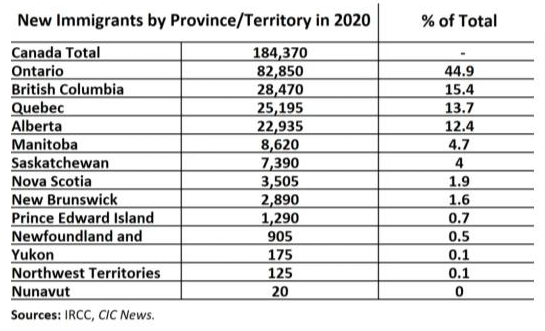
The immigration intake in Canada for 2020 has been a story of ups and downs in 2020 due to the Covid-19 pandemic. There was a drop in immigration numbers due to the lockdown and travel restrictions caused by the pandemic but it is hoped that most of the provinces will see their immigrant intake revived by the end of this year.
Canada welcomed just over 184,000 new immigrants in 2020 which was quite short of the 341,000 immigrants it had set as a target in 2020. The decline in immigrant numbers had affected each province and territory. But the good news is the pattern of settlement in immigrants was not affected by the pandemic.
The table below describes the intake by each province and territory in 2020:

Immigration numbers by 2020
Immigration to Ontario fell by almost half in 2020 to 83,000 but the percentage of immigrants was the same as 2019 which was 45%. British Columbia had the second highest number of immigrants at 30,000 which was 15% of the total intake. Quebec was at the third place with over 25,000 immigrants and its national share was 14%.
Provinces that saw a dip in intake numbers are Alberta which dropped to 12.4% compared to 13% in 2019. The shares of Manitoba declined from 5.5% in 2019 to 4.7% in 2020 and that of Saskatchewan fell from 4.6% to 4%.
The Atlantic provinces also saw a dip from 5.2% in 2019 to 4.7% in 2020.
What is in store for 2021?
Canada had announced an immigration target of 401,000 immigrants for 2021. An evidence of this is the Express Entry draw held on February 13 this year in which 27,332 candidates were given ITAs. All of the immigration candidates in this draw belonged to the CEC category out of which 90% were already in the country. This is evidence of the fact that at present Canada is looking at inviting temporary residents in Canada to transition to permanent residency.
According to Canada’s immigration minister, Marco Mendicino, the country welcomed 26,600 immigrants in January this year which is 10% higher than the immigration numbers during the same period in 2020. He also said that Canada is 40.5 % ahead in the pace it needs to maintain to achieve its immigration target for 2021.
The question is whether immigration will see a recovery across the provinces in 2021. While Express Entry will be the most popular way to welcome migrants, most of them in this category (92%) are expected to settle down in Ontario, Alberta and British Columbia.
Ontario is expected to see an increase in immigration numbers this year based on the temporary residents who will obtain permanent residency through Express Entry and the Ontario Immigrant Nominee Program (OINP). Family class immigrants are also expected to help in the recovery because this province has the greatest number of immigrants in this class.
British Columbia is expected to see a recovery because of its weekly PNP draws where a large number of temporary residents in the province become permanent residents.
Alberta has however reduced its intake through the AINP this year. The provinces of Saskatchewan, Manitoba, and the Atlantic provinces which rely on PNPs to bring in immigrants may not be able to bring in immigrants from abroad due to travel restrictions. The provinces mentioned above can rely on Express Entry to bring in more immigrants.
However, provinces that rely on the PNP can hope for more immigrants if the IRCC decides to convert more temporary residents to permanent residents since these provinces have a lot of international students. The IRCC has also indicated that it will look for ways other than Express Entry to welcome immigrants to the country.
As for Quebec it will also need to modify its strategy to meet its target of 44,500 immigrants for this year. While the QSWP may not able to welcome immigrants to its full potential due to the travel restrictions it can use the family sponsorship program and the Quebec Experience Program to welcome immigrants.
To deal with the decline in immigration and meet the immigration targets, the IRCC and provinces are looking at alternative ways to grant permanent residency to more immigrants till the travel restrictions are lifted.
For those who are outside Canada, they can submit their immigration applications now and for those with approvals, they can expect to migrate to Canada once the travel restrictions are lifted.



What were Canada’s immigration trends for 2020?
Posted on March 1, 2021